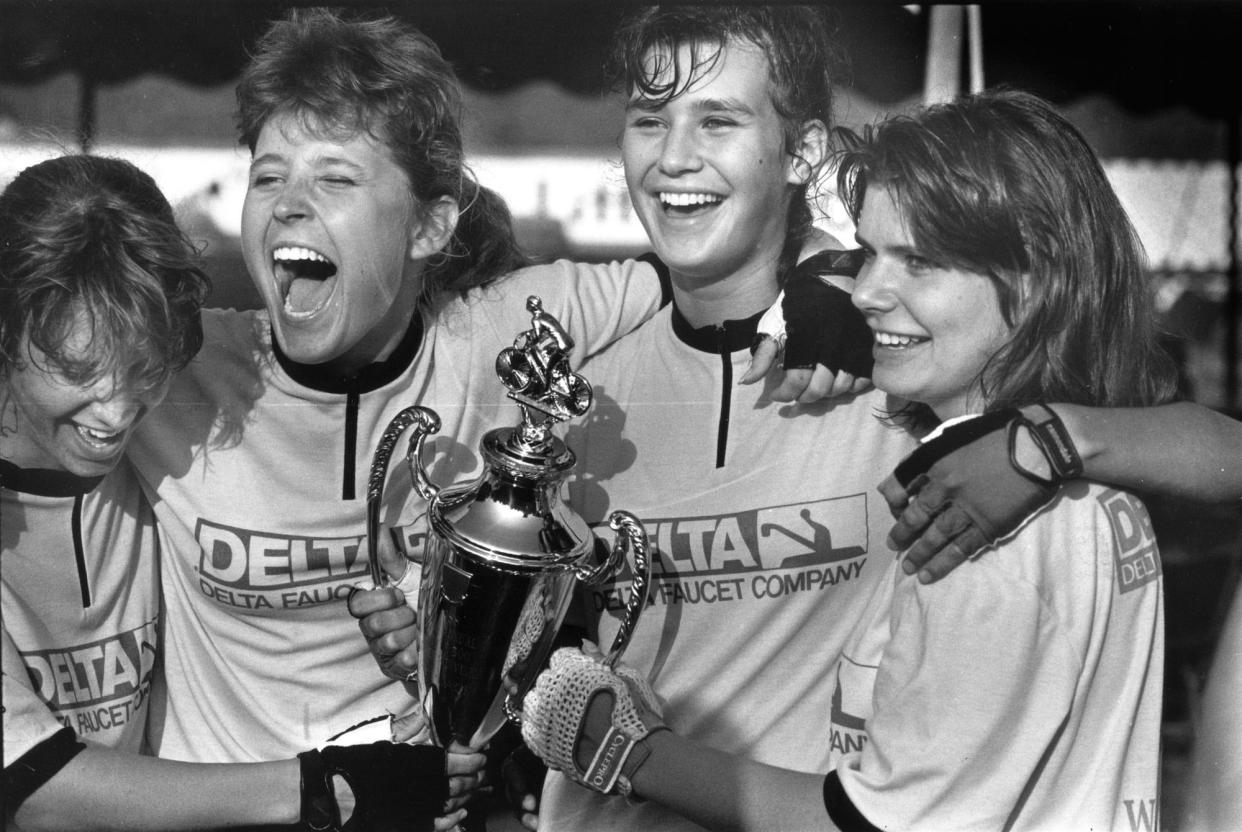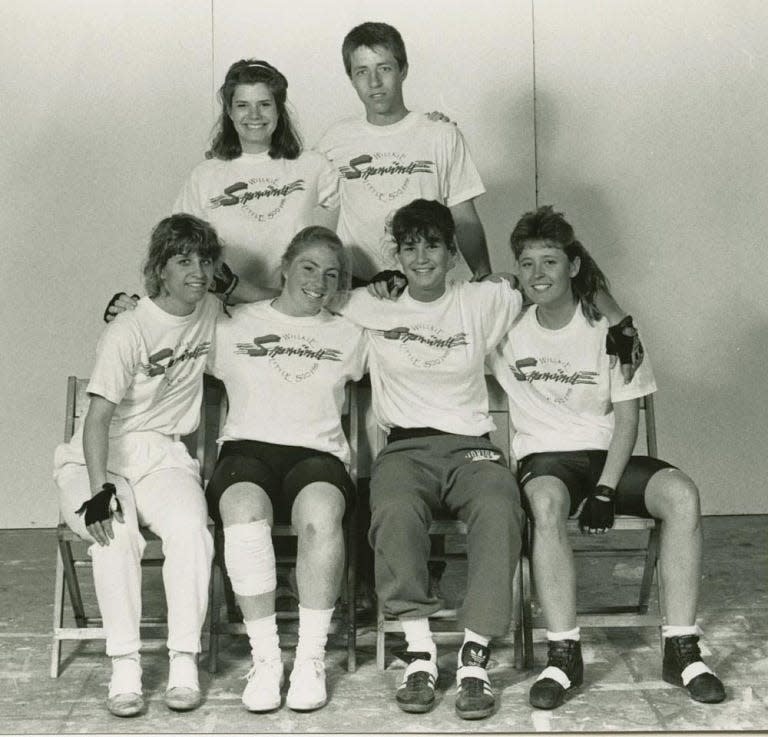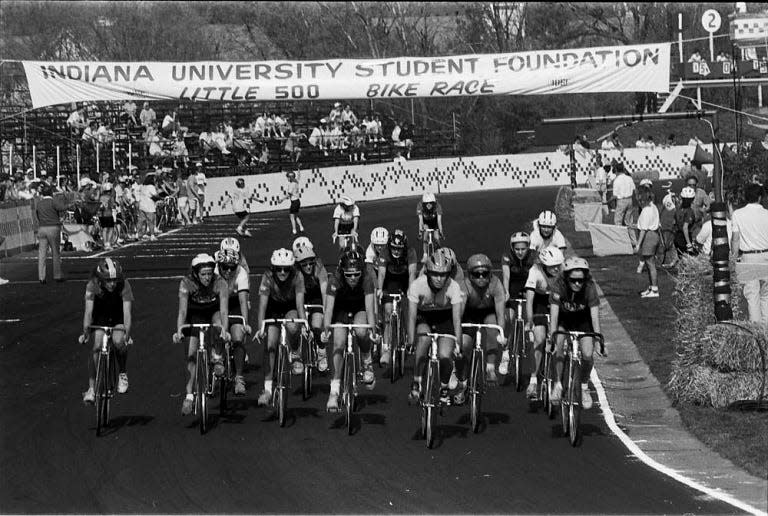From riding trikes to racing bikes like the men: The story of the first women's Little 500
Kerry Hellmuth showed up to Bloomington in the fall of 1987, an 18-year-old Wisconsin transplant who had fallen in love with the Indiana University campus, which on a sunny day was stunning with its flowering dogwoods, sugar maples and yellowwood trees.
She had visited other schools, and could have gotten into most of those schools, but IU was the only one she applied to. When she walked by the buildings crafted from the same limestone used to construct the Empire State Building, surrounded by majestic gardens, it felt like she was walking into the middle of a beautiful painting.
"I felt an immediate connection," said Hellmuth, now 54. "It was almost like a paradise."
When Hellmuth arrived to her room on the 11th floor, the top level of Willkie North, an all-female dorm tower which was the counterpart to the all-male Willkie South tower, her dad helped her unpack the family's VW Rabbit.
She and her roommate barely had time to settle in when a resident assistant, a senior named Crystal, called a welcome meeting for the 11th floor.
As the women sat with their entire college careers in front of them, Crystal talked about campus life, academia and extracurricular opportunities. She was particularly excited about a bike race Hellmuth had never heard of, the inaugural women's Little 500.
"Crystal said, 'We're going to have a dorm team and who wants to do it?'" Hellmuth said.

Hellmuth isn't sure what came over her, other than she was a definite tomboy who played just about every sport there was, trying to keep up with her two older brothers. She had never really cycled.
Still, when Crystal asked who was in, Hellmuth's hand immediately shot up. "So it was from the very start, from the very first day I was on campus, I committed to this bike race," she said.
Hellmuth had no idea at the time that she and her underdog Willkie Sprint dorm team would make IU history, a team of four freshmen winning the first women's Little 500 in front of 15,000 spectators at Bill Armstrong Stadium.
Hellmuth has written a book, “Willkie Sprint: A Story of Friendship, Love and Winning the First Women’s Little 500 Race," recounting that momentous race in April 1988, which was released this month.
"The story is not about winning a bike race," Hellmuth writes in the book. "It is about friendship, coming of age, laughter and love. This is my story. Lucky me."
'We were kind of scrappy'
The Little 500, the largest collegiate bike race in the United States, is held each spring on IU's campus, a competition patterned after its big brother of auto racing 56 miles north at Indianapolis Motor Speedway.
Riders compete in 4-person teams around a quarter-mile cinder track at Bill Armstrong Stadium. The men’s race is 200 laps (50 miles) and the women’s 100 laps (25 miles). The race and its festivities are often referred to as “The World’s Greatest College Weekend."
But before Hellmuth and her Willkie Sprint team, there had never been a women's winner. There had never been a women's race.
Hellmuth credits her victory not just to her teammates but to Kappa Alpha Theta's team of women who tried to qualify for the Little 500 the year before. While there was no women's race in 1987, women were not excluded from racing in the men's event. But they had to qualify.
"They garnered all the support and they qualified, but then the people behind them bumped them out of that spot, so they ended up out of the top 33 teams," said Hellmuth. "But that momentum and energy, and they really fought for it after a long line of other women right before them."
Kappa Alpha Theta's grassroots' effort to land a spot in the men's race may have failed, but it prompted a buzz and a major push. Women deserved their own race. After all, the men's race had been around since 1951 and had even inspired the 1979 Academy Award winning movie "Breaking Away."

In years past, as part of the festivities, women were relegated to a trike race.
"That's another theme in the book, this feminist thing because it's the first for women. We went from a trike race to the Little 500," said Hellmuth. "And it sounds absurd if you tell someone now. It's like, 'Are you kidding me? A trike race?' Yes, on big trikes."
So, when the women's Little 500 was announced in 1987, dorms and sororities went to work forming teams, including Willkie Sprint's group that included Hellmuth, Kirsten Swanson, Kristin McArdle, Amy Tucker, Louise Elder and coach Kevin Wentz.
For the next eight months, Hellmuth and her teammates would train to the point of exhaustion. Hellmuth would ride her bike to class, lock it up, and then train. She rode every chance she got. Morning, noon and night.
"We were pretty serious," said Hellmuth, who went on to cycle professionally. "We were kind of scrappy, but we were pretty athletic and pretty charged about."
Charged to give nothing less than their best.
“I can tell you that we were a small group of women that were just so competitive,” Kirsten Swanson, of Willkie Sprint said in 2022, according to Indiana University archives. “Most people wouldn’t make it on our team. I mean, if someone wasn’t throwing up or crying at the end of the training session, then you didn’t work hard enough.”
'More than just a cycling story'
The hard work paid off and on April 22, 1988, Willkie Sprint beat Kappa Alpha Theta by 9 seconds. Across from the team's pit were 40 journalists lined up shooting pictures and taking notes.
The next day, Hellmuth and Willkie Sprint's feat were splashed across newspapers nationwide, including a story in The New York Times.
"And we were just little 18-year-old freshmen and so it was amazing," said Hellmuth. But as an 18-year-old student still trying to find her way in life, Hellmuth said she didn't quite grasp at the time the magnitude of what she and her team had accomplished. She remembers a conversation with her dad after the race.
"My dad said to me, 'Oh, you're really lucky, hon, because you benefited from Title IX,'" Hellmuth recalls. "And I was like, 'I've heard of that. What is that again?'"
As the decades have passed, Hellmuth has been able to fully grasp her story. Being able to write it down, reflect on what it meant, not only to her personally, but the significance of this first for women, has been an incredible experience.

"What I did was I tried to weave together something more than just a cycling story. So, it wouldn't be just for IU students, it wouldn't be just for Little 500 riders or cyclists. It would be something that's about coming of age," said Hellmuth. "After all, it was just good fortune really, you know? It's just a race in circles, right?"
Attend the Little 500: The 36th running of the women's race is 4 p.m. Friday and the 73rd running of the men's race is 2 p.m. Saturday.
“Willkie Sprint: A Story of Friendship, Love and Winning the First Women’s Little 500 Race” is available at the IU bookstore and at the Little 500 on race day. Buy the book online at Amazon and IU Press.
Follow IndyStar sports reporter Dana Benbow on X: @DanaBenbow. Reach her via email: dbenbow@indystar.com.
This article originally appeared on Indianapolis Star: From trikes to racing bikes: The story of the first women's Little 500
